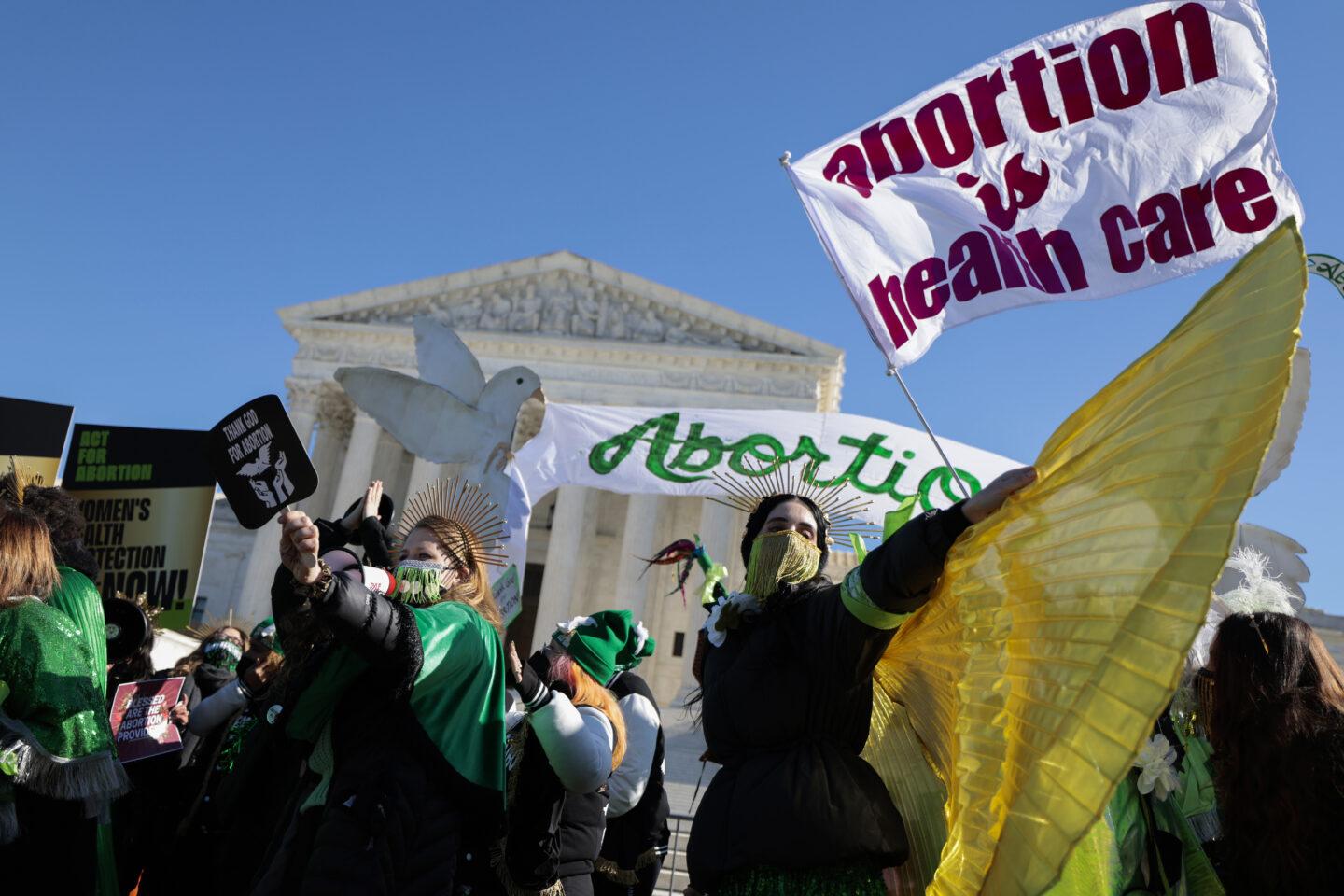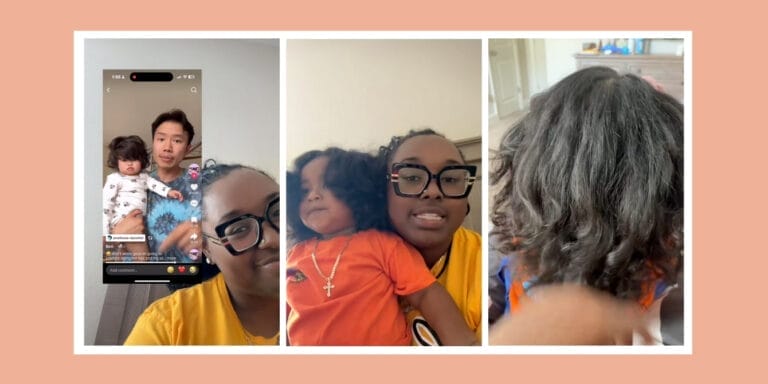What happens if Roe v. Wade gets overturned?

Anna Moneymaker / Getty
A leaked Supreme Court draft shows the Court will vote to strike down the landmark Roe v. Wade decision.
A version of this story was published on Feb. 8, 2022. It has been updated.
Table of Contents
- What is Roe v. Wade?
- Dobbs v. Jackson Women’s Health Organization: What you need to know
- How Donald Trump’s Supreme Court appointees factor in
- What happens if Roe gets weakened or overturned?
- What ACOG says about abortion
- What would be the consequences for Mississippi residents?
- How can I find out where my state stands?
- How can I get involved to help ensure Roe doesn’t get overturned?
- When is the Supreme Court scheduled to rule on Dobbs v. Jackson?
Editor’s note: On June 24, 2022, the Supreme Court voted to overturn Roe v. Wade. Read more about what to do now.
The Supreme Court has voted to strike down the landmark Roe v. Wade decision, according to a leaked draft majority opinion written by Justice Samuel Alito. After news of the leak broke in early May, people across the country shared their shock about the very real probability that the constitutional right to an abortion may soon be outlawed.
Notably, in Motherly’s State of Motherhood 2022 survey results, 60% of millennial & Gen Z mothers and 58% of Gen X mothers report personally supporting the reproductive rights movement. Only 16% of millennial & Gen Z mothers say they personally support the anti-abortion movement, while just 12% of Gen X mothers say they do.
The official decision regarding Roe will come in late June/early July, when the Supreme Court will likely make its most consequential decision on reproductive rights of the 21st century as it looks at Dobbs v. Jackson Women’s Health Organization.
The case could overturn the historic precedent set by 1973’s Roe v. Wade, which protects a woman’s right to abortion in the United States. It’s been nearly 50 years since the court ruled in favor of Roe, but recent developments in Mississippi and Texas have challenged the law. If you’re unclear on what happened, and what may happen to Roe and abortion rights, here’s how we got here.
What is Roe v. Wade?
For those who need a little refresher on the famous Roe v. Wade case, here it is: In 1969, Norma McCorvey, known in the case as Jane Roe, became pregnant with her third child. She wanted an abortion, but it was illegal in her state of Texas unless the mother’s life was in danger. She filed a lawsuit against her District Attorney Henry Wade, alleging the law was unconstitutional. The federal court ruled in her favor, but the state of Texas appealed directly to the Supreme Court. In January 1973, the Supreme Court voted 7–2 in favor of Roe, citing that the Due Process Clause of the 14th Amendment to the United States Constitution provides a “right to privacy” protecting a pregnant woman’s right to choose whether or not to have an abortion. The ruling also noted that this was not an absolute and took into consideration the safety of the mother and fetus, allowing states to determine in what trimester it was legal for a woman to terminate her pregnancy.
The Supreme Court revisited Roe in a 1992 ruling, Planned Parenthood v. Casey, and modified the framework for allowing abortion from trimesters to the gauge of fetal viability, while upholding that a person’s right to an abortion was constitutionally protected.
Related: Resources for safe abortion access and reproductive rights
Dobbs v. Jackson Women’s Health Organization: What you need to know
In 2018, Mississippi passed the Gestational Age Act, which makes abortions illegal after 15 weeks of pregnancy, except in cases of medical emergency or severe fetal abnormality. (That’s two months earlier than Roe.) The state justified the law by claiming that important physiological fetal developments are made by 15 weeks and terminating the pregnancy is riskier to the mother at this stage.
As Mississippi’s sole abortion clinic, the Jackson Women’s Health Organization provided a federal appeals court with evidence proving fetal viability is impossible at 15 weeks (most experts estimate it to be closer to 24 weeks). In 2019, the 5th U.S. Circuit Court of Appeals blocked the law on the grounds that the state hadn’t shown any medical evidence proving otherwise (Mississippi’s state health director Dr. Thomas Dobbs’ argument was that the eventual “development of an artificial womb” could make any fetus viable), but the Supreme Court was willing to hear the case nonetheless, and is expected to make a ruling this June.
How Donald Trump’s Supreme Court appointees factor in
During his time as president from 2016 to 2020, Donald Trump appointed three Supreme Court justices—Neil Gorsuch, Brett Kavanaugh and Amy Coney Barrett—which makes the high court a conservative majority of 6-3. During a confirmation hearing, the justice must pledge to rule by stare decisis, which is the doctrine of precedent, and not their personal views; however, if Roe is “settled law,” then why is the Supreme Court looking at the Dobbs v. Jackson case?
“It tells us that the court is willing to question the legality of abortion as a protected constitutional right,” Pro-Choice Oregon Deputy Director Jeanine Morales tells Motherly.
According to Dobbs’ petition, the court will be determining “whether all pre-viability prohibitions on elective abortions are unconstitutional.” The answer has been “yes” since the Roe ruling, but the current Supreme Court is the most conservative in a decade.
Ketanji Brown Jackson has been confirmed as the new Supreme Court justice to replace liberal justice Stephen Breyer; however this still won’t change the 6-3 conservative majority.
What happens if Roe gets weakened or overturned?
There is still a possibility that the court could uphold Roe, but choose to weaken its protections, which could allow states like Mississippi to enforce strict abortion laws. If the official ruling follows the leaked draft ruling, the Court will determine that Roe was wrongly decided and give states the ability to choose whether or not abortion is legal on the local level.
“If—or when—Roe is overturned, it will have far-reaching consequences that will impact everyone, regardless of what state you live in,” Morales says, “but will have a disproportionate effect and cause deeper harm to people who are already most impacted by economic and health disparities, including those who don’t have the resources to travel to other states for basic health care.”
If that happens, there are 21 states that have laws or constitutional amendments already in place to effectively ban abortion, known as “trigger bans,” with another five that have indicated they’d swing that way, too. Other states like California are proactively looking at ways to become sanctuaries for people who live somewhere that outlaws abortion in an effort to ensure that all people still have access to safe reproductive health services.
Related: What overturning Roe v. Wade could mean for women who experience pregnancy loss
“Nearly half of U.S. women, trans and gender non-binary people who can become pregnant—36 million people—are at risk of losing access to abortion,” Morales says. “It is estimated that 41% of women of reproductive age would see the nearest abortion provider close. Being able to obtain an abortion is bigger than just legality, it’s about access: where is your local clinic, is telemedicine and medication available, does your provider speak your language, do you trust your local health providers to provide non-judgemental, culturally-informed, high-quality health care?”
Vice President Kamala Harris mirrored that statement and took it a step further, telling the San Francisco Chronicle in late 2021 that “women will die” if Roe isn’t upheld. “In particular, women who don’t have economic resources and can’t then travel to places or somehow have access to safe reproductive health care, including abortion,” she added. “And it is not an extreme statement, it is a fact.”
What ACOG says about abortion
The American College of Obstetricians and Gynecologists (ACOG) supports access to safe abortion care, “which hinges upon the availability of sufficient numbers of trained abortion providers.”
Related: Plan C pills are safe and effective
What would be the consequences for Mississippi residents?
“On paper, the state law to ban abortion after 15 weeks would go into effect, and getting an abortion after 15 weeks would now be considered a criminal act,” Morales explains. “However, the effects are so much bigger. According to advocates in Mississippi, if the law passes, it means the one remaining abortion clinic in Mississippi will close its doors. This would require any person in Mississippi who needs an abortion, after four weeks, six weeks or 14.5 weeks to now be forced to travel out of state in order to get access to the care they need. This will mean that for many people, those without resources of money or time off work or childcare, will be forced to carry their pregnancies to full term.”
“There are studies like the Turnaway Study that show people who are denied access to an abortion experience long-term impacts,” she adds. “It can have a negative impact on someone’s long-term economic stability and their overall physical and mental health.”
Miscarriage care will likely also suffer following such a decision, notes Rabia Muqqadam, senior staff attorney for The Center for Reproductive Rights. “We already know that people who have miscarriages but still have fetal cardiac activity can struggle to get timely care because some consider managing such a miscarriage to be an abortion. When abortion is banned, all reproductive healthcare suffers because providers are chilled in providing care because they are afraid—this could impact miscarriage management even where there is no fetal cardiac activity and even in emergencies,” she notes.
And if abortion clinics close, it’s likely that more and more providers won’t be trained in effective reproductive healthcare—they may never even learn how to manage a miscarriage, Muqqadam notes. “After Roe, it could be that you end up in a hospital where not a single clinician can or will perform a D&C (the surgery used for both miscarriage and abortion) regardless of your circumstances.”
Related: How to care for yourself after an abortion
How can I find out where my state stands?
The Guttmacher Institute shared an in-depth report on what states would likely ban abortion if Roe gets overturned, and it also put together an interactive map showing the travel distance for people seeking abortions if reproductive rights do not get upheld.
How can I get involved to help ensure Roe doesn’t get overturned?
- SHERo Mississippi is a reproductive rights organization to support if you want to help people in Mississippi directly
- Yellowhammer is an abortion fund and reproductive rights organization serving the deep south
- We Testify strives to help end the stigma attached to abortion
- The National Network of Abortion Funds works to remove financial and logistical barriers to abortion access, specifically aiming to center those at the intersections of racial, economic, and reproductive justice.
- A donation to Planned Parenthood is also a way to help on a national level, and they’re always looking for volunteers if you’d rather give time than money
There are other non-monetary ways to help get involved, too. “Talk about abortion in a compassionate, non-judgmental way. Use your circle of influence to connect real people and their stories to the consequences of these awful laws,” Morales suggests. “[And] vote, especially in smaller races. Because the vast majority of Americans (7 or 8 out of 10) support abortion access, you’ll see anti-abortion campaigns coincide with restrictions on voting rights.”
When is the Supreme Court scheduled to rule on Dobbs v. Jackson?
The Supreme Court will make its formal decision on Dobbs v. Jackson by the close of its 2021-22 term, which ends in late June/early July.





































